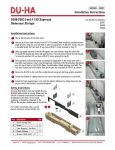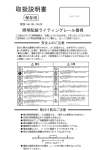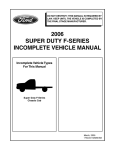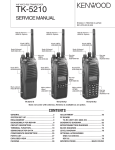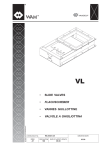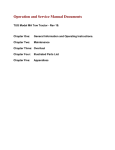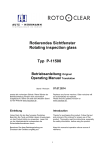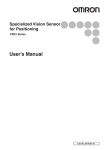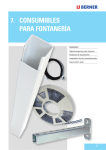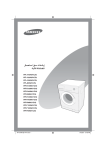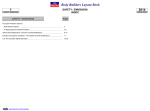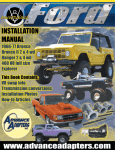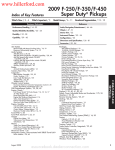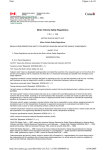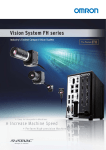Download pickup box removal / alterations
Transcript
Body Builders Layout Book 1 PICKUP BOX REMOVAL PICKUP BOX REMOVAL Design Recommendations PICKUP BOX REMOVAL / ALTERATIONS INDEX Page 2-7 Models & Wheel / Tire Data Super Duty F-Series 8 Ranger 9 Filler Pipe Location & Dimensions – Ranger 10 Rear Lamp Installation – Ranger 11 www.fleet.ford.com/truckbbas 2010 MODEL YEAR Body Builders Layout Book 2 PART I Introduction The following information is presented in three parts for vehicle alterers who intend to remove pickup boxes from certain Rangers and Super Duty F-Series pickup trucks, and install aftermarket second unit bodies on these vehicles. For vehicle alterers in California, see important information on page 6 concerning alteration of vehicles with a GVWR of 8500 lb or less for sale, registration, or use in California. Part I details those Ranger and Super Duty F-Series pickup models that may be altered by removal of the pickup box and installation of aftermarket second unit bodies and indicates where specific questions should be directed. Part II provides information concerning the obligations and responsibilities of vehicle alterers with respect to United States and Canada Motor Vehicle Safety Standards (F/CMVSS). Part III provides information for vehicle alterers with respect to United States, California, and Canada exhaust emissions, evaporative emissions and RFI requirements, and California requirements with regard to fuel vapor recovery. RANGER REGULAR CAB PICKUP BOX REMOVAL WILL AFFECT COMPLIANCE WITH THE DYNAMIC PERFORMANCE REQUIREMENTS OF F/CMVSS NO. 214 SIDE IMPACT PROTECTION FOR VEHICLES WITH A GVWR OF 2722 KG (6000 LB) OR LESS. Vehicle alterers who intend to modify vehicles, as described above, may use the information and conditions provided herein to assist them in determining whether modified vehicles comply with applicable regulatory requirements. Alternatively, the vehicle alterer may desire to employ other limits or conditions than those provided herein. IT IS THE RESPONSIBILITY OF THE VEHICLE ALTERER TO ASSURE COMPLIANCE AND CERTIFICATION OF THE ALTERED VEHICLE TO THE APPLICABLE SAFETY AND/OR EMISSIONS (INCLUDING NOISE AND RFI) REQUIREMENTS. Specific questions concerning compliance and/or certification to safety standards and emissions and fuel economy regulations should be directed to the vehicle alterer’s legal counsel or the United States National Highway Traffic Safety Administration (FMVSS and Federal Fuel Economy Standards and requirements), the Canada Ministry of Transport (CMVSS, emissions, and noise regulations), the Canada Department of Communications (Canadian RFI regulations), the United States Environmental Protection Agency (EPA) (United States emission requirements) or the California Air Resources Board (California emissions and fuel 2010 PICKUP BOX REMOVAL / ALTERATIONS DESIGN RECOMMENDATIONS PICKUP BOX REMOVAL vapor recovery requirements), and the vehicle noise emission control authorities, if any, in the state and locality in which the vehicle is sold. If you have technical, product-related questions concerning some aspect of the vehicle alteration, a representative of Ford Motor Company will be happy to talk with you. Please contact your regional sales office or phone the Ford Truck Body Builders Advisory Service directly at 1-877-840-4338. Models Available for Pickup Box Removal The models listed in Table A, page 7 (Super Duty FSeries) and Table A, page 8 (Ranger SuperCab), may be altered by removing the pickup boxes and installing aftermarket second unit bodies. For Ranger SuperCab vehicles available for pickup box removal, Ford Motor Company specifies that they shall be equipped with front and rear stabilizer bars. Limitations on the second unit bodies that may be installed, as well as other vehicle conditions, are also specified in Table A, and in the Safety / Emissions section. PART II Information Concerning United States and Canada Safety Standards The vehicle alterer is responsible for certifying the altered vehicle pursuant to Title 49 of the Code of Federal Regulations Sections 567.7 and 568.8 in the United States, or pursuant to Section 9 of the Canadian Motor Vehicles Safety Regulations in Canada. As outlined in these requirements, the vehicle alterer must ascertain which F/CMVSS are affected by the alteration, and subsequently provide certification that the altered vehicle conforms to all affected safety standards. In the information that follows, Ford has endeavored to provide sufficient instructions and guidelines to the vehicle alterer for certifying that the vehicle conforms to all F/CMVSS affected by the vehicle alteration. Information pertaining to Certification Labeling Requirements for the altered vehicle is outlined in page 4. Federal and Canadian Standards Compliance Motor Vehicle Safety Conformity to the following FMVSS (FMVSS) and Canadian Motor Vehicle Safety Standards (CMVSS) are affected by the removal of the pickup box and rear bumper and installation of an aftermarket second unit body: F/CMVSS No. 105(5) — Hydraulic Brakes F/CMVSS No. 108 — Lighting Equipment F/CMVSS No. 111 — Rear view Mirrors (5) — Light Vehicle Brakes (1) — Steering Control Rearward Displacement — Occupant Crash Protection — Windshield Mounting — Side Impact Protection — Windshield Zone Intrusion — Fuel System Integrity F/CMVSS No. 135 F/CMVSS No. 204 F/CMVSS No. 208(2) F/CMVSS No. 212(3) F/CMVSS No. 214(3)(4) F/CMVSS No. 219(3) F/CMVSS No. 301(3) For Motor Company represents that, in the case of a Ranger SuperCab or Super Duty F-Series pickup truck listed in Table A, page 7 (Super Duty F-Series) and Table A, page 8 (Ranger SuperCab), this vehicle, as altered, will conform to the requirements of the previously listed safety standards, provided the vehicle is altered only by the removal of the pickup box (including optional equipment attached to the pickup box) and rear bumper (if so equipped), and the installation of an aftermarket Second Unit Body (SUB) in accordance with the following conditions: 1. The following lighting components must be designed and installed on the altered vehicle in accordance with the requirements of F/CMVSS No. 108, Lamps, Reflective Devices, and Associated Equipment. Tail Lamps* Stop Lamps* License Plate Lamps* Back-Up Lamps* Rear Turn Signal Lamps* Rear Side Marker Lamps* Rear Side Reflex Reflectors* Reflectors* Rear Side Marker Lamps Front and Rear Identification Lamps (for vehicles over 80 inches in width) Front and Rear Clearance Lamps (for vehicles over 80 inches in width) Center High Mounted Stop Lamp (if second unit body blocks view of the CHMSL on the back of the cab another CHMSL must be added) The items of lighting equipment (including wiring and power supply) on the cab of the pickup truck must not be removed, modified, replaced, or altered. Further, the second unit body installed by the vehicle alterer must not impair the visibility and conformity to the photometric requirements of the lamps and reflective devices installed on the cab of the pickup truck. MODEL YEAR 2. The weight (in pounds) of the Second Unit Body (SUB) installed must be within the range specified in Tables A, pages 7 - 8 corresponding to the particular pickup truck model and not greater than the weight (in pounds) calculated using the following formula: SUB WEIGHT LIMIT = Unloaded Vehicle Weight (UVW) – Original Equipment Manufacturer (OEM) Curb Weight + Pickup Box + Options Removed. Super Duty F-Series • Step Bumper – 74 lb. • Pickup Box – see Table A • Spare Wheel and Tire – see Table B Ranger SuperCab • Step Bumper – 37 lb. • Pickup Box – see Table A • Spare Wheel and Tire – see Table B Alterers must not remove, alter or modify in any way the Ranger Ford factory-installed frame mounted trailer hitch receiver. Any Ranger Second Unit Body (SUB) must be attached using 10 attachment points with fasteners of equivalent size and grade of those removed from the Ford factory-installed pickup box. NOTES — (1) For vehicles with a GVWR of 10,000 lb or less and an unloaded vehicle weight of 5500 lb or less. (2) Injury criteria is applicable to vehicles with a GVWR of 8500 lb or less and an unloaded vehicle weight of 5500 lb or less. (3) Applicable to vehicles with a GVWR of 10,000 lb or less. (4) Dynamic Performance Requirements apply to MPV, Truck, or a Bus with a GVWR of 2722 Kg (6000lb) or less for FMVSS only. (5) Standard 135 applied to vehicles with a GVWR of 3500 Kg (7716 lb) or less. Standard 105 applies to vehicles with a GVWR over 3500 Kg (7716 lb). * These lamps and reflectors are available from Ford in the form of rear lamp assemblies and are the same as those installed on Ford chassis cab models. (Cont'd next page) www.fleet.ford.com/truckbbas Body Builders Layout Book 3 PICKUP BOX REMOVAL / ALTERATIONS DESIGN RECOMMENDATIONS (Cont'd) PICKUP BOX REMOVAL PART II (Cont'd) RANGER SUPERCAB PICKUP BOX REMOVAL REQUIREMENTS FOR F/CMVSS 301: Ref: BBAS Quality Bulletin Q183 The Ranger SuperCab will conform to F/CMVSS Standard 301 Fuel System Integrity provided the vehicle is altered only by the removal of the pickup box (including all equipment attached to the pickup box) and rear bumper system followed by the installation of an aftermarket Second Unit Body (SUB). The fuel fill system must be installed as specified in this book. The factory fuel system and associated components can not be removed nor modified, and all fuel system clearances must meet recommendations contained within the Body Builders Layout Book. Additionally, the following requirements must also be adhered to: ● ● Alterers must not remove, alter, nor modify in any way the Ford Motor Company factoryinstalled frame-mounted trailer hitch receiver. The Second Unit Body (SUB) must be attached using 10 attachment points with fasteners of an equivalent size and grade to those removed from the Ford Motor Company installed pickup box. F250/350 PICKUPS WITH GVWR RATINGS OF 10,000 LBS OR LESS PICKUP BOX REMOVAL REQUIREMENTS FOR F/CMVSS 301: 2010 MY Vehicles built on or after September 1, 2009: Vehicles with a Ford Motor Company manufacturer build date on or after September 1, 2009 are required to comply to a revised F/CMVSS Standard 301 that is effective September 1, 2009. Vehicles will comply if guidelines and recommendations are followed as specified in the 2010 Truck Body Builders Layout Book. Information is also available in the 2010 Super Duty F-Series Incomplete Vehicle Manual (August, 2009 edition) Standard 301 pass-thru compliance guidelines relative to the fuel system, chassis and trailer hitch receiver. The IVM is available at www.fleet.ford.com/truckbbas under the “Publications” tab. The revised additional requirements are summarized as follows: General Upfit Requirements: ● ● Ref: BBAS Quality Bulletin Q183 2010 MY Vehicles Built Through August, 31, 2009: Vehicles with a Ford Motor Company manufacturer build date up to and including August 31, 2009 will comply with F/CMVSS Standard 301 if guidelines and recommendations are followed as specified in the 2010 Body Builders Layout Book. Information is also available in the 2010 Super Duty F-Series Incomplete Vehicle Manual (January, 2009 edition) Standard 301 pass-thru compliance guidelines relative to the fuel system, chassis and trailer hitch receiver. The IVM is available at www.fleet.ford.com/truckbbas under the “Publications” tab. 2010 MODEL YEAR Except for a service body upfit with a rear bumper, there must not be any components that tie a second unit body (SUB) to the frame rearward of rear spring's rear hanger/shackle brackets. Note that components for lateral support may be bolted or welded to either the chassis (only) or the second unit body (only). A service body upfit with a rear bumper attached via a bracket that ties the second unit body (SUB) to the frame must not exceed 6.35mm [0.25 in,] gauge thickness. Additional Requirements for Platform/Stake Body Upfits: ● ● For platform/stake body upfits only, second unit body (SUB) longitudinal rail supports must not exceed 6.35mm [0.25 in.] gauge thickness. To obtain pass-thru compliance to Standard 301 for a platform/stake body upfit, the factory-installed 12.5K rated frame mounted trailer hitch receiver must be removed and replaced with a 16K trailer hitch receiver (Ford Engineering Part Number BC34-19D521-B, Ford Service Part Number BC3Z-17D826-B). The trailer tow capability of the vehicles remain unchanged as specified in the vehicle owner's guide and the Ford Motor Company 2010 RV and Trailer Towing Guide. Any questions should be directed to the Body Builder Advisory Service at www.fleet.ford.com/truckbbas . (Cont'd next page) www.fleet.ford.com/truckbbas Body Builders Layout Book 4 PART II (Cont’d) 5. These instructions must be followed in the vehicle alteration: • The following components, as installed by Ford Motor Company, are not to be removed, relocated, altered, or modified in any way: Example A vehicle alterer wants to remove the pickup box and rear step bumper from a Super Duty F-250 Regular Cab (4x4), 137-inch WB model with a 5.4L engine, automatic transmission, and air conditioning having a curb weight of 6200 lb and install a 600-pound Second Unit Body (SUB). First, Table A (on page 7 ) specifies that the maximum SUB weight is 1800 lb. Since the SUB weight is 600 lb, this condition is satisfied. Second, the SUB weight must not exceed the SUB WEIGHT LIMIT calculated below: SUB WEIGHT LIMIT = Maximum Complete Unloaded Vehicle Weight (UVW) minus the unloaded vehicle weight as delivered (OEM) curb weight plus pickup box weight removed plus weight of removed options. SUB WEIGHT LIMIT = 6900 – 6200 + 380 + 74 SUB WEIGHT LIMIT = 1154 lb The 600 lb SUB is less than 1154 lb and, accordingly, may appropriately be installed as planned. The vehicle alterer must either select a lighter weight SUB, reduce the OEM accessory weights for the vehicle, or both if the SUB is heavier than the maximum limit. 1. OEM Curb Weight includes Base Vehicle Weight (with full fuel), engine and transmission weight, and all OEM accessory weights ordered or installed (Refer to the appropriate Truck Source Book or the CD version of this publication for weight data). 2. Options removed include step bumpers or similar OEM options permanently removed from the vehicle. 3. The center of gravity height and overall height of the second unit body installed by the alterer must not exceed the values specified in Table A, pages 361362 corresponding to the particular pickup model. Center of gravity height and overall height of the second unit body are measured from the top surface of the frame at the rear of the cab. 4. The altered vehicle’s unloaded vehicle weight (see Definitions in Safety/Emission section) must not exceed the values designated in Table A pages 361362 corresponding to the pickup truck’s model and non-California engine-transmission combination. 2010 PICKUP BOX REMOVAL / ALTERATIONS DESIGN RECOMMENDATIONS (Cont'd) PICKUP BOX REMOVAL • – Steering column, steering shaft, steering wheel, and related structural components and attachment hardware – Windshield and windshield mounting system positions (as defined in F/CMVSS No. 208)(2); any additional loss of windshield retention (as defined in F/CMVSS No 212)(3); any change in the performance requirements of F/CMVSS 214(3)(4); any penetration of the inner surface of the windshield or intrusion into the protected zone (as defined in F/CMVSS No. 219)(3); or loss of fuel system integrity (as defined in F/CMVSS No. 301)(3); when the vehicle is tested in any manner specified by applicable provisions of F/CMVSS Nos. 105(5), 135(5), 204(1), 208(2), 212(3), 214(3(4), 219(3), and 301(3), respectively. – Cab and front end structural components, including the roof, pillars, cowl, cowl reinforcements, hood, doors, fenders, hood restrictors and apron reinforcements, and frame and frame reinforcements – Radio antenna – Doors and hood mounting, hinging, and latching systems – Hood and fender ornamentation – Fuel tank and attachment hardware, including sending unit and vapor valve, fuel tank shield, and in-tank electric fuel pump (for gasoline engine only) – Fuel lines, routing, and attachments, excluding fuel filler cap, filler pipe, filler hose(s), and filler system attachment hardware, which must be removed and replaced – Vapor line(s) and carbon canister(s) – Fuel pump – Fuel filter and attachment – Air cleaner assembly – Safety belts – Front seat head restraints – Electrical grounds on all components (must be retained) – The Powertrain Control Module (PCM), and – Catalyst and Exhaust System. Any alteration or modification made to the vehicle, as manufactured by Ford Motor Company, and any components or structure installed by the vehicle alterer must not result in steering column rearward displacement of more than 5 inches (as defined in F/CMVSS No. 204)(1); no modification to the Hydraulic Brake System that would affect compliance to F/CMVSS No 105 or 135(5); an increase in injury potential for front outboard seating NOTE: Federal Motor Vehicle Safety Standard (FMVSS) and Canadian Motor Vehicle Safety Standard (CMVSS) No 204 are not applicable to a vehicle with an unloaded vehicle weight greater than 5500 lb. F/CMVSS No. 208 injury criteria are applicable only to vehicles with a GVWR of 8500 lb or less and an unloaded vehicle weight of 5500 lb or less. Conformity to Federal Motor Vehicle Safety Standard (FMVSS) and Canadian Motor Vehicle Safety Standard (CMVSS) No. 212 and 219 for vehicles having a gross vehicle weight rating (as defined in 49 CFR, Part 571.3) no greater than 10,000 lb, is established for representative vehicles at a vehicle weight provided by Sections S6.1(b) and S7.7(b) of FMVSS No. 212 and 219, respectively, and provided by Sections 5.1 and 8 of CMVSS No. 212 and 219, respectively. • – Trailer hitch receiver • The second unit body installed shall be mounted securely and so designed that when the altered vehicle is impacted in any manner specified by applicable provisions of F/CMVSS No. 212(3) and 219(3), second unit body deformation or movement relative to the frame does not result in any separation or loss of body attachment to the frame. The second unit body installed and the required fuel system components (identified below) shall be located and mounted as follows: MODEL YEAR – The second unit body shall be mounted securely and is so designed that when the altered vehicle is tested in any manner specified by applicable provisions of F/CMVSS No. 301(3): (a) Second unit body components shall not contact any fuel system component (other than at the points where the fuel system is permanently attached to the second unit body) and (b) Second unit body deformation or movement relative to the frame shall not cause any fuel system component to be penetrated, disconnected, or otherwise damaged. – The rear end of the second unit body (excluding the rear bumper) installed shall not extend beyond (overhang) the rear edge of the vehicle frame or frame extension. Any extension of the vehicle frame must be constructed and attached so as to perform as a continuation of the vehicle frame when the altered vehicle is tested in any manner specified by applicable provisions of F/ CMVSS No. 301(3). – See the Design Recommendations, Second Unit Body (SUB) attachment section of this book for additional information. – The fuel filler cap, filler pipe, filler hose(s), and filler system attachment hardware for vehicles with diesel engines and for vehicles with gas engines shall be installed, as shown in the Super Duty F-Series section and shall be securely retained to remain intact when the vehicle is tested in any manner specified by applicable provisions of F/CMVSS No. 301(3). NOTES — (1) For vehicles with a GVWR of 10,000 lb or less and an unloaded vehicle weight of 5500 lb or less. (2) Injury criteria is applicable to vehicles with a GVWR of 8500 lb or less and an unloaded vehicle weight of 5500 lb or less. (3) Applicable to vehicles with a GVWR of 10,000 lb or less. (4) Dynamic Performance Requirements apply to MPV, Truck, or a Bus with a GVWR of 2722 Kg (6000lb) or less for FMVSS only. (5) Standard 135 applied to vehicles with a GVWR of 3500 Kg (7716 lb) or less. Standard 105 applies to vehicles with a GVWR over 3500 Kg (7716 lb). (Cont'd next page) www.fleet.ford.com/truckbbas Body Builders Layout Book 5 PART II (Cont’d) • The front end of the second unit body installed shall be located at least three inches rearward of the rearmost point of the cab on Super Duty F-Series, and at least 1.4 inches rearward of the rearmost point of the cab on Ranger SuperCab models. • The vehicle, as produced by Ford, meets the Center High Mounted Stop Lamp (CHMSL) requirements of Standard 108, Lighting. Compliance to these criteria may be affected by the installation of a Second Unit Body (SUB), if the SUB blocks the view of the CHMSL mounted on the back of the cab. When this happens, the subsequent manufacturer must install a CHMSL on the SUB that meets FMVSS 108. An electrical feed for installation of a CHMSL on the SUB is provided and is located inside the rearmost crossmember near the end of the left frame rail on the Super Duty F-Series models. For the Ranger, directions are given in Ford Bulletin Q-28, CHMSL – Precautions and Guidelines for Adding or Locating. • The vehicle, as produced by Ford, meets F/CMVSS No. 111. Compliance to F/CMVSS No.111 may be affected, however, by removal of the pickup box and installation of a Second Unit Body (SUB), even though the mirror system has not been altered. A discussion of compliance, with respect to each mirror type, follows: – Sail-Mounted Type Outside Mirror on Super Duty F-Series or Ranger Pickup. Provided the mirrors, driver’s seat, and cab are not altered, the mirror system will continue to meet Standard No. 111. if the overall width of the Second Unit Body (SUB) is no wider than the pickup box, and if the view of the roadway behind the vehicle through the inside mirror is not totally blocked off. If the SUB blocks the view through the inside mirror, a flat glass mirror is required on the passenger’s side in place of the convex mirror on vehicles to be sold in the United States. Vehicles for sale in Canada may be equipped with the convex mirror on the passenger’s side when the SUB blocks the view through the inside mirror. If the SUB is wider than the pickup box, both the driver’s side and passenger’s side mirrors may have to be replaced with mirrors providing a wider view to the rear. – Trailer Tow Mirrors on Super Duty F-Series. These mirrors will continue to meet Standard No. 111, provided the mirrors, the driver’s seat, and the cab are not altered. 2010 PICKUP BOX REMOVAL / ALTERATIONS DESIGN RECOMMENDATIONS (Cont'd) PICKUP BOX REMOVAL • If the front bumper and bumper mounting system are removed temporarily, the front bumper and bumper mounting system must be reinstalled in accordance with the instructions provided in the Ford Truck Service Manual. If the front bumper and bumper mounting system are replaced, the replacement front bumper and bumper mounting system must not result in: steering column rearward displacement of more than 5 inches (as defined in F/CMVSS No. 204)(1); any increases in injury criteria (as defined in F/CMVSS No. 208)(2); any additional loss of windshield retention (as defined in F/CMVSS No. 212)(3); any penetration of the inner surface of the windshield or intrusion into the protected zone (as defined in F/CMVSS No. 219)(3); or, loss of fuel system integrity (as defined in F/CMVSS No. 301(3)), when the vehicle is impacted in any manner specified by applicable provisions of those standards. NOTE: The second unit body added by the vehicle alterer may have to conform to other safety standards as well. For example, any glazing used in the second unit body must conform to F/CMVSS No. 205, Glazing Materials. Additionally, if the second unit body is equipped with any passenger seating positions, the following safety standards may be applicable as well: F/CMVSS No. 206 — Door Locks and Retention F/CMVSS No. 207 — Seating Systems (2) F/CMVSS No. 208 — Occupant Crash Protection F/CMVSS No. 209 — Seat Belt Assemblies F/CMVSS No. 210 — Seat Belt Anchorages (3)(4) F/CMVSS No. 214 — Side Impact Protection F/CMVSS No. 302 — Flammability of Interior Materials With respect to the second unit body installed and the above-mentioned safety standards, it is the responsibility of the vehicle alterer to assure conformity with all applicabl requirements. It is the responsibility of the vehicle alterer to determine which other safety standards, if any, their vehicles must comply with. NOTE: See statements for F/CMVSS No. 105 and 135, Hydraulic Brake implications of modifications/alterations to completed vehicles, including pickup box removal vehicles in the Safety/Emission section. MODEL YEAR Certification Labeling Requirements For altered vehicles in the United States, the vehicle alterer is required to affix an additional label containing the information shown in the Safety / Emissions section. NOTE: The safety standard certification label, which is affixed to the driver’s door latch pillar of the pickup truck, by Ford Motor Company must not be removed. For altered vehicles in Canada, the vehicle alterer is required to affix a label containing the information shown in the Safety / Emissions section. NOTE: A vehicle alterer may be a manufacturer according to the definition of manufacturer contained in the Canadian Motor Vehicle Safety Act. PART III Information concerning United States and Canada Exhaust Emissions, Evaporative Emissions, RFI and Noise, and California Fuel Vapor Recovery Requirements. Refer also to pages within the Safety / Emissions section. THE INFORMATION HEREIN IS PROVIDED AS GUIDANCE ONLY. IT IS THE RESPONSIBILITY OF THE VEHICLE ALTERER TO ASSURE COMPLIANCE OF THE ALTERED VEHICLE WITH THE APPLICABLE EMISSION REQUIREMENTS. A copy of the appropriate Ford Truck Owner’s Guide and Warranty Facts Booklet is installed in the altered pickup truck prior to sale to the ultimate purchaser in order to provide emission systems warranty information and maintenance schedules. Note: Whether Ford Motor Company or the alterer is responsible for emission warranty claims depends on, among other things, whether the vehicle failed to comply with applicable warranty provisions because of modifications made by the alterer or because of the original design and manufacture of the vehicle. Questions concerning requirements and policies, with respect to alterers of completed vehicles, should be directed to body builder’s legal counsel, the Environmental Protection Agency, or the California Air Resourses Board. A. Exhaust Requirements and Evaporative Emission Ranger SuperCab completed trucks have been certified to the applicable U.S. Federal, California, or Canadian exhaust and evaporative emissions requirements. See Safety / Emissions section for important information on altering vehicles with an 8500 lb GVWR or less to be for sale, registration, or use in California. Federal law specifies that a light-duty truck is any vehicle with a GVWR of 8500 lb or less that has a vehicle curb weight of 6000 lb or less, and a basic vehicle frontal area of 45 square feet or less, which is designed primarily for transporting property (or is a derivative of such a vehicle), or is designed primarily for transporting persons and has a capacity of more than 12 persons, or is available with special features enabling off-street or off-highway operation and use. All complete and some incomplete heavy-duty vehicles up to 14,000 lbs GVWR are emission certified to the chassis certification provisions of 40 CFR, Part 86, Subpart S, and the requirements & restrictions of Subpart S apply. All heavy-duty engines (in some incomplete vehicles having a GVWR of 8500 to 14,000 lb GVWR and all vehicles over 14,000 lb GVWR for the United States and Canada) have been certified to the applicable U.S. Federal or Canadian exhaust or California exhaust and evaporative emissions requirements for heavy-duty engines. Ranger SuperCab and Super Duty F-Series pickup truck models listed in Tables A on pages 7 - 8 , if altered by removal of the pickup box (including items attached to the pickup box), rear bumper (if so equipped), and installation of a second unit body, may not require recertification to applicable Federal, California, or Canadian emissions requirements if the following conditions are satisfied: 1. None of the emission control hardware furnished with the pickup truck is deleted, modified, or rendered inoperable. A listing of such hardware is provided in the Emission Control Modifications section in the Safety/Emission section of this book. NOTES — (1) For vehicles with a GVWR of 10,000 lb or less and an unloaded vehicle weight of 5500 lb or less. (2) Injury criteria is applicable to vehicles with a GVWR of 8500 lb or less and an unloaded vehicle weight of 5500 lb or less. (3) Applicable to vehicles with a GVWR of 10,000 lb or less. (4) Dynamic Performance Requirements apply to MPV, Truck, or a Bus with a GVWR of 2722 Kg (6000lb) or less for FMVSS only. (Cont'd next page) www.fleet.ford.com/truckbbas Body Builders Layout Book 6 PART III (Cont’d) 2. The Super Duty F-Series fuel filler kit that is supplied with the vehicles ordered with pickup box delete option number 66D or available through Ford dealers. Installation must be as shown in the Super Duty F-Series section. Filler system attachment hardware for Ranger SuperCab in kit 9B149 is shown installed in this section on following pages. 3. The alterer does not exceed the limitations listed in Safety / Emissions pages under “Curb Weight and Frontal Area Restrictions”. Note: If the weight of the altered vehicle exceeds the maximum unloaded vehicle weight specified in Table A pages 7 - 8 , corresponding to the particular pickup truck model and engine combination, the vehicle alterer is required to certify the vehicle to: F/CMVSS 105 or 135(5), Brakes; F/CMVSS No. 204(1), Steering Control Rearward Displacement; F/CMVSS No.212(3), (3)(4) Windshield Mounting; F/CMVSS No. 214 , Side (3) Impact Protection; and F/CMVSS 219 , Windshield Zone Intrusion; and F/CMVSS No. 301(3), Fuel System Integrity, in addition to compliance with any other F/ CMVSS affected by the vehicle’s alteration. 2010 PICKUP BOX REMOVAL / ALTERATIONS DESIGN RECOMMENDATIONS (Cont'd) PICKUP BOX REMOVAL 4. For a chassis certified pickup truck having a GVWR of up to 14,000 lb, other than those for sale, registration or use in California, the alterer does not add more than 500 lb to the maximum unloaded vehicle weight specified in Table A pages 7 - 8 corresponding to the particular pickup model. (a) IMPORTANT: Some of the preceding conditions are based, in part, on statements made by C. N. Freed of the Environmental Protection Agency (EPA) in a letter of July 13, 1979 to M. H. McBride, legal counsel of the Recreation Vehicle Industry Association. That letter explained EPA’s policy concerning alterers of complete 1980 and later model year light-duty trucks in the context of EPA’s Advisory Circular No. 64 – a March 7, 1977 publication that provides guidance on the need for separate certification of vehicles modified after original manufacture, but prior to sale and delivery to the ultimate purchaser. The maximum second unit body weights provided in tables on pages 7 - 8 are calculated in accordance with the definition of “maximum vehicle weight” provided in the July 13, 1979 letter. The referenced letter provides that alterers of complete light-duty trucks need not recertify such vehicles for emission control purposes if: 1) the altered vehicles conform, in all material respects, to the design specifications in the original manufacturer’s application for certification, and 2) the weight of the altered vehicle, including the weight of fuel at nominal tank capacity, is no more than 500 lb above the “maximum vehicle weight.” The letter further states that no frontal area restrictions will apply to alterers who comply with conditions (a) and (b) above. Alterers who do not comply with these conditions will be considered manufacturers under the Clean Air Act and will be required to assure that the altered vehicles are certified. Questions concerning EPA’s policies, with respect to alterers of completed vehicles, should be directed to legal counsel or the Environmental Protection Agency. (b) NOTE: (For a pickup truck having a GVWR of 10,000 lbs or less) If the weight of the altered vehicle exceeds the maximum unloaded vehicle weight specified in Table A, corresponding to the particular pickup truck model and non-California engine-transmission combination, the vehicle alterer is required to certify the vehicle to: F/CMVSS No. 105 or 135, Brakes; F/CMVSS No. 204, Steering Control Rearward Displacement (if the unloaded vehicle weight is 5500 lb or less); F/CMVSS No. 208, Occupant Crash Protection (if the GVWR is 8500 lb or less and the unloaded vehicle weight is 5500 lb or less); F/CMVSS No.212, Windshield Mounting; F/CMVSS No. 2143)(4), Side Impact Protection; F/CMVSS No. 219, Windshield Zone Intrusion; and F/CMVSS No. 301, Fuel System Integrity, in addition to compliance with any other F/CMVSS affected by the vehicle’s alteration. See next page for important information concerning alteration of light-duty trucks and chassis certified medium duty vehicles rated at 14,000 lb GVWR or less, for sale, registration, or use in California. B. High Altitude Emissions Vehicles sold for principal use in high altitude areas must comply with the High Altitude Regulations. United States Environmental Protection Agency regulations contain unique emission certification requirements for trucks that will be sold or delivered to customers for principal use above 4,000 feet (1219 meters). Certain new vehicles cannot be sold to customers who intend to use them principally at high altitudes. TO AVOID ANY QUESTION OF CERTIFICATION COVERAGE, ORDERS SHOULD SPECIFY WHETHER A HIGH ALTITUDE EMISSION SYSTEM OR A NON-HIGH ALTITUDE EMISSION SYSTEM IS REQUIRED. C. California Fuel Vapor Recovery California regulations require that vehicle fuel systems be designed to accommodate a new vapor-recovery fueling nozzle, including unobstructed access to the fill pipe. Fuel filler pipes, installed per Super Duty F-Series section of this book will comply with the “Specifications for Fill Pipes and Openings of Motor Vehicle Fuel Tanks,” referenced in Title 13 California Administrative Code, providing no part of the second unit body, as installed, intrudes within the access zone defined in CARB regulation 13 CCR § 2235. Fuel filler pipes, installed using the alternate bracket shown on the figures in Super Duty F-Series section of this book will comply with the above California vapor recovery regulations, provided the second unit body installed does not interfere with the access zone. MODEL YEAR D. Radio Frequency Interference (RFI) 1. UNITED STATES RADIO FREQUENCY INTERFERENCE (RFI) INFORMATION Devices that emit radio frequency (RF) energy, such as AM/FM radios and radio-controlled theft alarms, marketed for sale or use in the United States, are subject to the rules and regulations of the Federal Communications Commission (FCC) 47 C.F.R. Parts 2 and 15. These rules specify the following conditions of operation: This device complies with Part 15 of the FCC rules. Operation is subject to the following two conditions: (1) This device may not cause interference, and (2) The device must accept any interference received, including interference that may cause undesired operation. In addition, the FCC’s rules may require the device to be tested and found to comply with various RF interference emissions limits before it may be marketed. The FCC established different limits, according to the particular use and installation of RF devices. In some cases, a grant of equipment authorization from the FCC also must be obtained before and RD device may be marketed. To ensure continued compliance with the FCC’s requirements, the owner, user, custom manufacturer, or service technician must not modify or change the RF device in a manner not expressly approved by Ford Motor Company. Such modifications could void the authority to operate the device. NOTES — (1) For vehicles with a GVWR of 10,000 lb or less and an unloaded vehicle weight of 5500 lb or less. (2) Injury criteria is applicable to vehicles with a GVWR of 8500 lb or less and an unloaded vehicle weight of 5500 lb or less. (3) Applicable to vehicles with a GVWR of 10,000 lb or less. (4) Dynamic Performance Requirements apply to MPV, Truck, or a Bus with a GVWR of 2722 Kg (6000lb) or less for FMVSS only. (5) F/CMVSS 135 is applicable to vehicles with a GVWR of 3500 Kg (7716 lb) or less. F/CMVSS 105 is applicable to vehicles with GVWR over 3500 Kg (7716 lb). (Cont'd next page) www.fleet.ford.com/truckbbas Body Builders Layout Book 7 PART III (Cont'd) • Only “static conductive” accessory drive belts should be used. Fan, water pump, power steering, and other belts should be on the OEM type or equivalent that will not build up a static electrical charge. • Engine component wiring must not be rerouted in any manner. • The Powertrain Control Module (PCM) must not be relocated from the position as installed by Ford Motor Company. 2. CANADIAN RADIO FREQUENCY INTERFERENCE (RFI) INFORMATION All vehicles powered by spark ignition engines (e.g., gasoline, natural gas, or propane engines) and manufactured in Canada or for sale or use in Canada, are subject to the Canadian “Regulations for the Control of Interference to Radio Reception” per Interference-Causing Equipment Standard (ICES-002) and applicable test method according to “CAN/CSE-C108, 4-M92”. Violation of these regulations is punishable by fine or imprisonment. Ford-built vehicles were designed and manufactured to be capable of meeting the regulatory requirements or such modifications, thereof, as may have been authorized by the Department of Communications. However, because Ford has no control over how an altered vehicle is completed by subsequent stage manufacturers, Ford does not represent that the completed vehicle, incorporating the Ford-built components, will comply with applicable requirements. The following information is supplied to subsequent stage manufacturers to help them avoid increasing the RFI emissions of this vehicle in the course of completing it. For any altered vehicle, additional measures may be needed to adequately suppress RFI emissions. Affected components could include spark plugs, electronic engine control module, ground straps, ignition component shields, accessory drive belts, and instrument voltage regulator suppressor assembly. More specifically: • All components required to suppress RFI emissions, which are removed during service, repair, or completion of the vehicle, must be reinstalled in the manner in which they were installed by Ford. • Shields on ignition coil must remain installed. • Replacement of spark plugs, ignition wires, and ignition coil must be equivalent in their RFI suppression properties to original equipment. • Electrical grounds on all components must be retained. • Metallic components installed on the body or chassis must be grounded to the chassis. • Electrical circuits added to the vehicle must not be installed near the high voltage ignition components. www.fleet.ford.com/truckbbas 2010 PICKUP BOX REMOVAL / ALTERATIONS DESIGN RECOMMENDATIONS (Cont'd) PICKUP BOX REMOVAL E. Noise Canadian Motor Vehicle Safety Standard (CMVSS) Section 1106 Noise Emissions prescribes maximum permissible exterior sound levels of 83 dB(A) for “heavyduty vehicles,” with a GVWR between 6001 and 10,000 lb, where such levels are measured in accordance with SAE Recommended Practice Standard J986a, “Sound Level for Passenger Cars and Light Trucks” (August 1994) or SAE Standard J1470, Measurement of Noise Accelerating Highway Vehicles (March, 1992). Under the Canada Motor Vehicle Safety Standards, a “heavyduty vehicle” is a bus, a Chassis Cab, a multipurpose passenger vehicle, or a truck having a gross vehicle weight rating of more than 6000 lb, but not a passenger car. However, Transport Canada’s tabulation of CMVSS indicates that CMVSS No. 1106 does not apply to incomplete vehicles unless the incomplete vehicle is fitted with a cab and has a GVWR more than 10,000 lb (4356 kg). A pickup truck listed in tables on pages 7 - 8 , if altered only by the removal of the pickup box (including optional equipment attached to the pickup box) and rear bumper (if so equipped), is designed and built to conform to the applicable exterior noise emission limits of CMVSS NO. 1106 subsection (2)(b). The alterer is, of course, responsible for determining that the vehicle, as altered, complies with CMVSS No. 1106. WARNING — VEHICLE OPERATING TEMPERATURES Some trucks of Ford Motor Company may exhibit high engine compartment and exhaust system temperatures in some operating modes. Components, including exhaust heat shielding systems, have been installed on some vehicles in our assembly plants in an effort to provide protection against such temperatures. Subsequent aftermarket installers/manufacturers are responsible for providing thermal protection (e.g., underbody heat shields) for any structure/equipment added to the vehicle, and should not remove any components/exhaust heat shielding installed on the vehicles by Ford. Also, the added structure/equipment should not restrict air circulation in the engine compartment or underbody. See applicable sections under “Ambulance Builders Guidelines” in the Design Recommendations section. Any interior floor underlayment or insulation in the near vicinity of the exhaust system, without benefit of the Ford-provided heat shields, must be capable of withstanding 371° C and 482° C [900° F] in close proximity to the catalyst during normal operating conditions. Additionally, any under chassis-mounted component, within 4 inches of the exhaust system, must be compatible with these temperatures. IMPORTANT INFORMATION CONCERNING ALTERATION OF LIGHT-DUTY TRUCKS AND CHASSIS CERTIFIED MEDIUM DUTY VEHICLES WITH A GVWR OF UP TO 14,000 LB FOR SALE, REGISTRATION, OR USE IN CALIFORNIA Ranger SuperCab pickup trucks, listed in Table A on page 8 and manufactured by Ford Motor Company for sale, registration, or use in California, can be altered by removal of the pickup box (including items attached to the pickup box) and rear bumper (if so equipped) and installation of a second unit body, if all of the following conditions are satisfied. For additional information concerning noise control laws and regulations issued by the Federal (U.S.) Government, as well as some states and municipalities, see Vehicle Noise Regulations in the Safety/Emissions section. 1. Conditions numbered 1, 2, 3, and 4 under Section A entitled “Exhaust and Evaporative Emission Requirements” pages 4 - 5 , and those under Section C, entitled “California Fuel Vapor Recovery”, as they apply to light duty trucks and medium duty vehicles. 2. The vehicle alterer does not increase the vehicle’s unloaded vehicle weight by more than 10% over the maximum curb weight (unloaded vehicle weight specified in tables on pages 7 - 8 corresponding to the particular pickup model), does not increase the frontal area by more than 10%, or does not provide a combination increase of weight plus frontal area of more than 14%. NOTE: The maximum unloaded vehicle weight, specified in tables on pages 7 - 8 for California, is the curb weight – the basic curb weight plus the weight of options of greater than 33% installation rate. MODEL YEAR NOTE: If the weight (in pounds) of the altered vehicle exceed the maximum unloaded vehicle weight specified in tables on pages 7 - 8 , corresponding to the particular pickup truck model, the vehicle alterer is required to certify the vehicle to: F/CMVSS No. 105 or 135, Brakes; F/CMVSS No. 204, Steering Control Rearward Displacement (if the unloaded vehicle weight is 5500 lb or less); F/CMVSS No. 208 (if the unloaded vehicle weight is 55 lb or less); F/CMVSS No. 212, Windshield Mounting; F/CMVSS No. 219, Windshield Zone Intrusion; and F/ CMVSS No. 301, Fuel System Integrity, in addition to any other F/CMVSS to which conformity is affected by the vehicle’s alteration. 3. No axle ratio, tire size or tire type changes are made that would increase the drivetrain ratio by more than five percent. Altered vehicles which do not satisfy these conditions may not be sold, offered, or delivered for sale, or registered in California, unless the altered vehicle is certified by the California Air Resources Board, pursuant to all applicable emissions requirements. The vehicle alterer is responsible for obtaining such certification. Questions regarding these requirements should be directed to your legal counsel or the California Air Resources Board. Body Builders Layout Book 8 TABLE A – SUPER DUTY F-SERIES MODELS AVAILABLE FOR PICKUP BOX REMOVAL Second Unit Body Limits Body Style Regular Cab SuperCab Crew Cab a/ b/ c/ 2010 PICKUP BOX REMOVAL / ALTERATIONS SUPER DUTY F-SERIES MODELS & WHEEL / TIRE DATA PICKUP BOX REMOVAL Model F-250 F-250 F-350 F-350 F-350 F-350 F-350 DRW F-350 DRW F-250 F-250 F-250 F-250 F-350 F-350 F-350 F-350 F-350 F-350 F-350 F-350 F-350 DRW F-350 DRW F-250 F-250 F-250 F-250 F-350 F-350 F-350 F-350 F-350 F-350 F-350 F-350 F-350 DRW F-350 DRW F-350 DRW F-350 DRW WB [in] Drive 4x2 4x4 4x2 4x4 4x2 4x4 4x2 4x4 4x2 4x4 4x2 4x4 4x2 4x4 4x2 4x4 4x2 4x4 4x2 4x4 4x2 4x4 4x2 4x4 4x2 4x4 4x2 4x4 4x2 4x4 4x2 4x4 4x2 4x4 4x2 4x4 4x2 4x4 137.0 137.0 137.0 137.0 137.0 137.0 137.0 137.0 141.8 141.8 158.0 158.0 141.8 141.8 141.8 141.8 158.0 158.0 158.0 158.0 158.0 158.0 156.2 156.2 172.4 172.4 156.2 156.2 156.2 156.2 172.4 172.4 172.4 172.4 156.2 156.2 172.4 172.4 5.4L 8800 9000 10,000 10,000 10,100 10,100 11,800 12,000 9000 9200 9200 9400 10,000 10,000 10,100 10,200 10,000 10,000 10,100 10,400 12,200 12,400 9200 9400 9400 9600 10,000 10,000 10,100 10,400 10,000 10,000 10,200 10,600 12,200 12,400 12,400 12,400 GVWR [lb] Weight Max. Heighta/ 6.8L Min [lb] Cgb/ [in] 9000 9200 10,000 10,000 10,100 10,200 12,000 12,200 9200 9400 9400 9600 10,000 10,000 10,200 10,400 10,000 10,000 10,200 10,600 12,400 12,600 9400 9600 9600 9800 10,000 10,000 10,200 10,600 10,000 10,000 10,400 10,800 12,400 12,600 12,600 12,600 6.4L 9400 9600 10,000 10,000 10,200 10,600 12,400 12,600 9600 9800 9800 10,000 10,000 10,000 10,400 10,800 10,000 10,000 10,600 11,000 12,800 13,000 9800 10,000 10,000 10,000 10,000 10,000 10,600 11,000 10,000 10,000 10,800 11,200 12,800 13,000 13,000 13,000 380 380 380 380 380 380 420 420 340 340 380 380 340 340 340 340 380 380 380 380 420 420 340 340 380 380 340 340 340 340 380 380 380 380 420 420 420 420 17.6 17.6 17.6 17.6 17.6 17.6 24.0 24.0 24.0 24.0 24.0 24.0 24.0 24.0 24.0 24.0 24.0 24.0 24.0 24.0 24.0 24.0 24.0 24.0 24.0 24.0 24.0 24.0 24.0 24.0 24.0 24.0 24.0 24.0 24.0 24.0 24.0 24.0 TABLE B – SUPER DUTY F-SERIES TIRE AND WHEEL WEIGHTS Wheel Size Maximum Complete Vehicle UVW [lb]c/ 5.4L Gasoline 6.8L Gasoline 6.4L Diesel 7329 7329 7329 7329 7160 7464 7160 7464 7750 8274 7750 8274 — — — — — — — — — — — — 7070 7564 7719 7719 7070 7564 7205 7699 7560 7854 7205 7699 8025 8539 8150 8664 8025 8539 — — — — — — 7719 7719 7560 7854 8150 8664 — — — — — — — — — — — — 7439 7933 7564 8068 7439 7933 7574 8068 7699 8203 7574 8068 8364 8878 8489 9013 8364 8878 — — — — — — 7564 8068 7699 8203 8489 9013 — — — — — — — — — — — — — — — — — — Vertical height measured from the top surface of the frame at the rear of the cab. Maximum SUB center of gravity (CG) shown in this table is only allowable if F/CMVSS 105 criteria are satisfied per calculation in the Safety/Emission section of this book. Weight shown is maximum allowable for safety certification for vehicles with a GVWR less than or equal to 10,000 lbs. www.fleet.ford.com/truckbbas MODEL YEAR Wheel (only) Weight [lb] 17x7.5 (Steel Wheel – F250/350 – SRW) 38.5 17x7.5 (Chrome Clad – F250/350 – SRW) 40.0 17x7.5 (Aluminum Wheel – F250/350 – SRW) 24.3* 17x6.5 (Steel Wheel – F350 – DRW) 40.0 17x6.5 (Aluminum Wheel – F350 – DRW) 25.1 18x8.0 (Steel Wheel – F250/350 – SRW) 45.0 18x8.0 (Aluminum Wheel – F250/350 – SRW) 27.6* 18x8.0 (Chrome Clad – F250/350 – SRW) 46.8 19.5 x 6.0 (Steel Wheel – F450/550 – DRW) 51.0 19.5 x 6.0 (Aluminum Wheel – F450/550 – DRW) 33.6 19.5 x 6.0 RW (Steel Wheel – DRW) 52.0 19.5 x 6.75 K (Steel Wheel – DRW) # 42.5 Tire Size Tire Weight [lb] LT245/75R17 53.8 LT265/70R17 55.4 LT275/65R18 55.0 LT275/70R18 59.2 225/70Rx19.5 58.0 * Average weight of all tire brands/type offered in that size # Motorhome Body Builders Layout Book 9 2010 PICKUP BOX REMOVAL / ALTERATIONS RANGER MODELS & WHEEL / TIRE DATA PICKUP BOX REMOVAL MODEL YEAR TABLE A – RANGER SUPERCAB MODELS AVAILABLE FOR PICKUP BOX REMOVAL TABLE B – RANGER TIRE AND WHEEL DATA Second Unit Body Limits Wheel Size Max. Heighta/ GVWR [lb] Min [lb] Maxb/c/ [lb] Cgc/ [in] Overall [in] Maximum Complete Vehicle UVWR [lb] Weight Wheel (only) Weight [lb] 15 x 6.0 JJ (base argent steel) 20.4 15 x 7.0 JJ (silver styled steel) 22.6 15 x 7.0 JJ (silver aluminum) 14.5 15 x 7.0 JJ (chrome steel) 23.9 Description Model Drive WB [in] SuperCab XLd/ 4x2 126 4600 230 1000 11.5 39.75 3950 16 x 7.0 JJ (5-spokle cast aluminum) 16.2 XLd/ 4x2 126 4920 230 1040 11.5 39.75 4150 15 x 7.0 JJ (8-hole forged aluminum) 16.9 XLTe/ 4x2 126 4760 230 960 11.5 39.75 3910 16 x 7.0 JJ (5-spoke cast aluminum) 20.5 XLTe/ 4x2 126 5020 230 960 11.5 39.75 4070 Edgee/ 4x2 126 4840 230 680 11.5 39.75 3990 XLTe/ 4x4 126 5080 230 834 11.5 39.75 4208 XLTe/ 4x4 126 5260 230 833 11.5 39.75 4208 a/ Vertical height measured from the top surface of the frame at the rear of the cab. b/ Maximum Second Unit Body (SUB) weight for any model is the lesser of two values shown below: • The value listed here or; • The value determined by: SUB WEIGHT = MAX UVW – (OEM Wet Curb Weight) + Pickup Box + Options Removed. c/ Maximum SUB weights and center of gravity (CG) shown in this table are only allowable if F/CMVSS 135 criteria are satisfied per calculation Safety/Emission section of this book. Rear step bumper..............................................37 lb Spare tire and wheel assembly..........................Table B d/ Models without rear jumpseats. e/ Models with rear jumpseats. www.fleet.ford.com/truckbbas Tire Size Tire Weight [lb] P235/75R-15SL 28.2 P225/70R-15SL 24.1 P245/75R-16SL 30.8 31X10.5R15 43.2 Body Builders Layout Book 10 2010 PICKUP BOX REMOVAL / ALTERATIONS RANGER FILLER PIPE LOCATION & DIMENSIONS PICKUP BOX REMOVAL MODEL YEAR DIM. NOTES – PROVIDE ADEQUATE SUPPORT OF FUEL FILLER AND VENT HOSES TO ENSURE A CONTINUOUS DOWNWARD SLOPE FROM FUEL INLET TO TANK. (RECOMMENDED 2 DEGREES) FRONT OF VEHICLE TO BACK OF CAB CL FUEL FILL C L OF FILL PIPE ASY AND BRACKET W709654-S424 SCR & WSHR M4.2x1.41x22.0 HEX TAP C #4 C/MEMBER VENT TUBE SCREWS (3) REQD TORQUE 2.3-3.32 Nm (20-29 INLB) FILL TUBE D ATTACH GROUND STRAP TO UPPER STEEL PORTION OF FUEL FILL NECK TOP OF FRAME RAIL DO NOT TRIM STEEL END BB0445 2004 www.fleet.ford.com/truckbbas A SUPERCAB 198 [7.8] C SUPERCAB 443 [17.4] D SUPERCAB 224 [8.8] USE COMPONENTS FROM FUEL FILL SYSTEM INSTALLED BY FORD. REMOVE FROM VEHICLE HOSES, CLAMPS AND CAP FOR USE WITH FILL PIPE KIT. USE NEW HOSES, PIPE, STEEL PORTION, TIEWRAPS AND CLAMPS PROVIDED IN KIT TO CONNECT FUEL FILL SYSTEM FROM TANK TO UNIT BODY AS SHOWN. FUEL FILL AND VENT HOSES PROVIDED IN KIT MAY REQUIRE TRIMMING AS SHOWN IN FIGURE. THE RESULTING TRIMMED FILLER SYSTEM SHOULD PROVIDE A DIRECT DOWNWARD SLOPE TO THE FUEL TANK FROM THE METAL PIPE WHILE AVOIDING KINKS WHICH RESTRICT FUEL FLOW. ADDITIONAL SUPPORT MAY BE REQUIRED TO PREVENT SAGGING OR MISORIENTATION. FAILURE TO DO SO WILL RESULT IN SPRAY OR SPIT-BACK DURING THE FUELING OPERATIONS. Body Builders Layout Book 11 2010 PICKUP BOX REMOVAL / ALTERATIONS RANGER REAR LAMP INSTALLATION PICKUP BOX REMOVAL MODEL YEAR 6 6 8 11 9 11 8 10 9 10 5 4 3 9 7 9 INSTALLATION FOR RANGER 4 x 2 MODELS (LEFT–HAND REAR LAMP 2 7 (RIGHT–HAND REAR LAMP 1 ASSEMBLY) ASSEMBLY) NOTE: WIRE HARNESS ROUTING DIFFERENCES BETWEEN 4 x 2 AND 4 x 4 MODELS 6 11 6 8 9 8 10 11 9 10 5 4 3 INSTALLATION FOR RANGER 4 x 4 MODELS 7 (LEFT–HAND REAR LAMP 2 7 (RIGHT–HAND REAR LAMP 1 ASSEMBLY) SERVICE PART NUMBERS 1. E4TZ–13404–C 2. E4TZ–13405–C 3. C7TZ–13406–A 4. E0TZ–13470–C 5. E0TZ–13471–A 6. 34659–S36M 7. 55653–S36 ASSEMBLY) PART DESCRIPTION RIGHT–HAND REAR LAMP ASSEMBLY LEFT–HAND REAR LAMP ASSEMBLY SERVICE PART NUMBERS 8. 353473–S36 9. 384646–S LICENSE PLATE BRACKET RIGHT–HAND MOUNTING BRACKET 2 REQUIRED 4 x 4 MODELS) (SPLIT LINE IN GROMMET MUST BE AT TOP, IN VERTICAL POSITION) LEFT–HAND MOUNTING BRACKET NUT AND WASHER ASSEMBLY (4 REQUIRED) 10. 34661–S36 (TORQUE TO 3–7 POUND–FEET) BOLT (4 REQUIRED) 11. E3TZ–13A409–A NUT AND WASHER ASSEMBLY (4 REQUIRED) (TORQUE TO 12–20 POUND–FEET) WIRING HARNESS (CONNECT TO MAIN WIRING ASSEMBLY) – RANGER ONLY BB0220 REAR LAMP ASSEMBLY INSTALLATION AND PARTS LIST www.fleet.ford.com/truckbbas PART DESCRIPTION CLIP (2 REQUIRED) GROMMET (4 REQUIRED FOR 4 x 2 MODELS;











